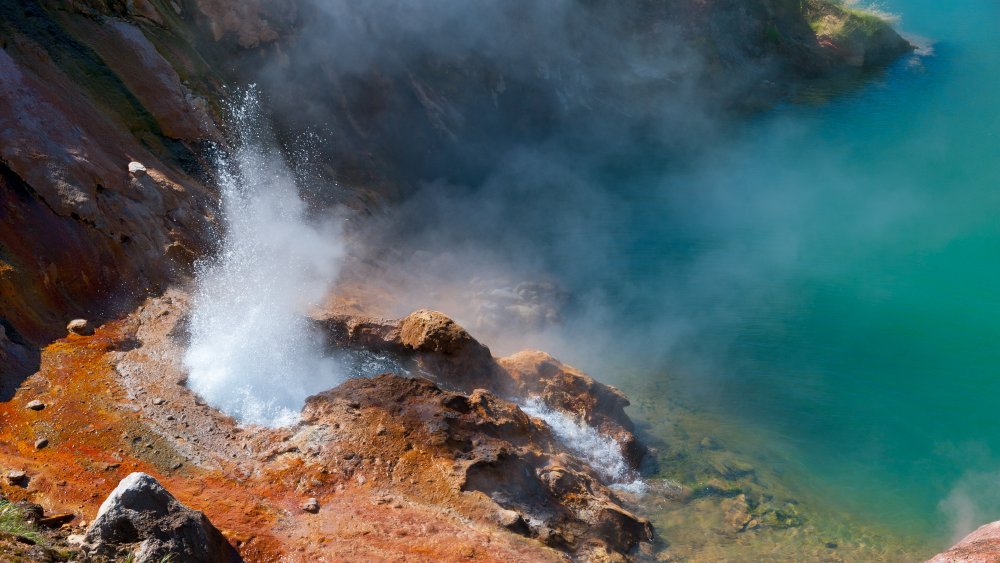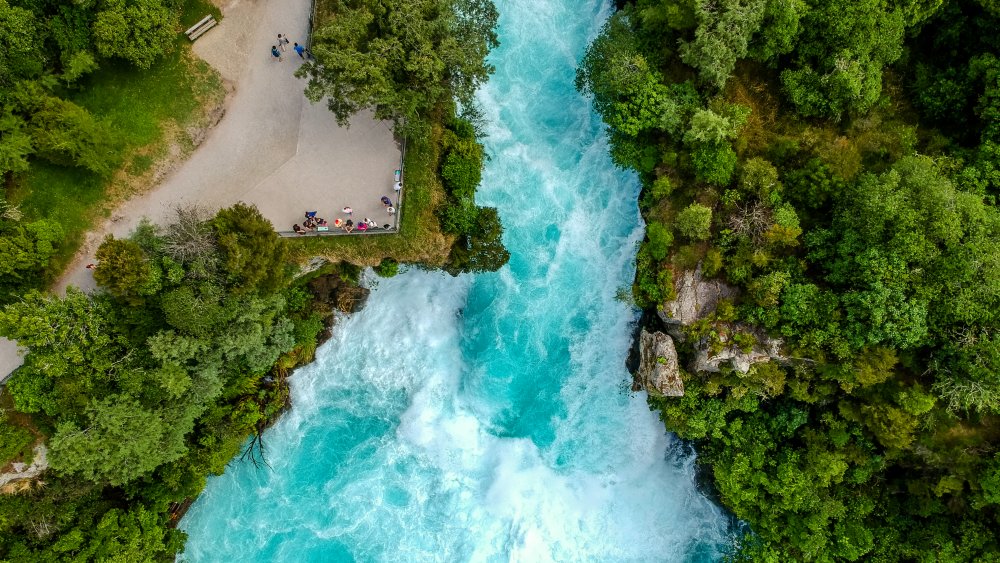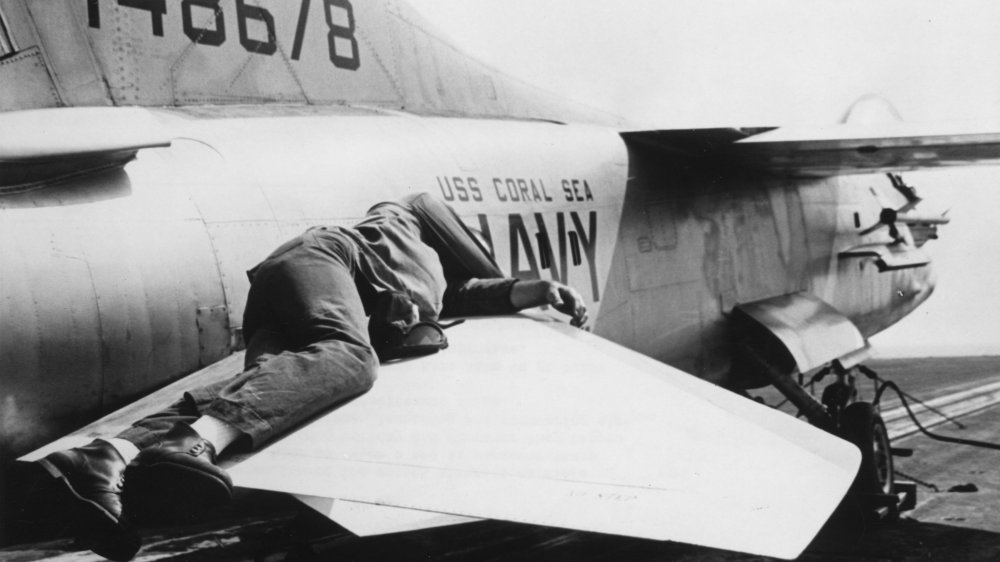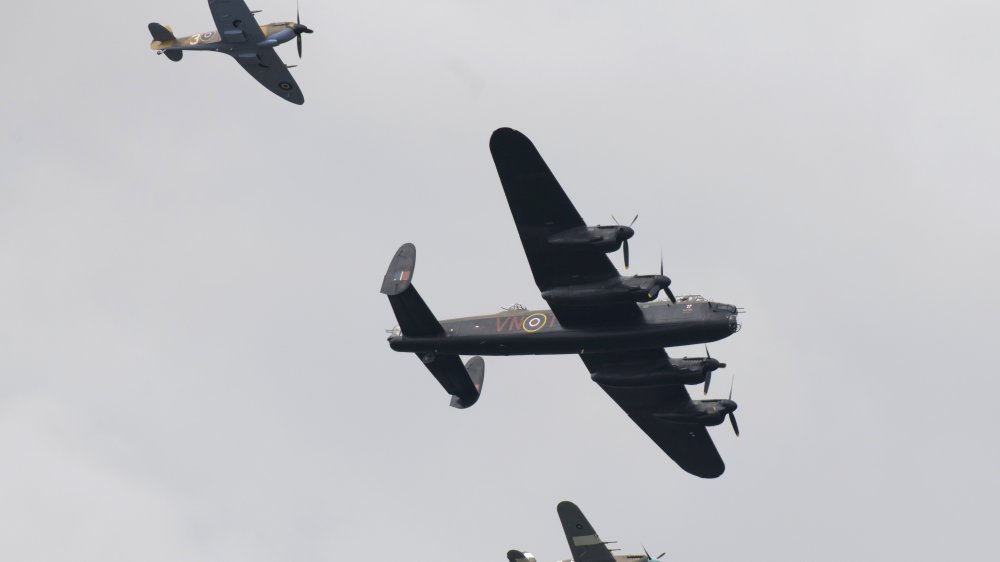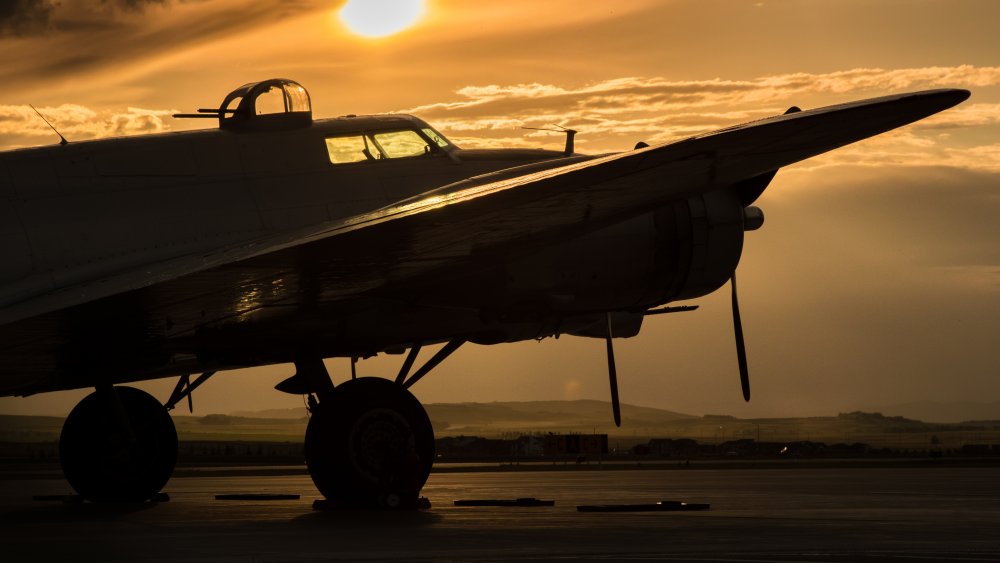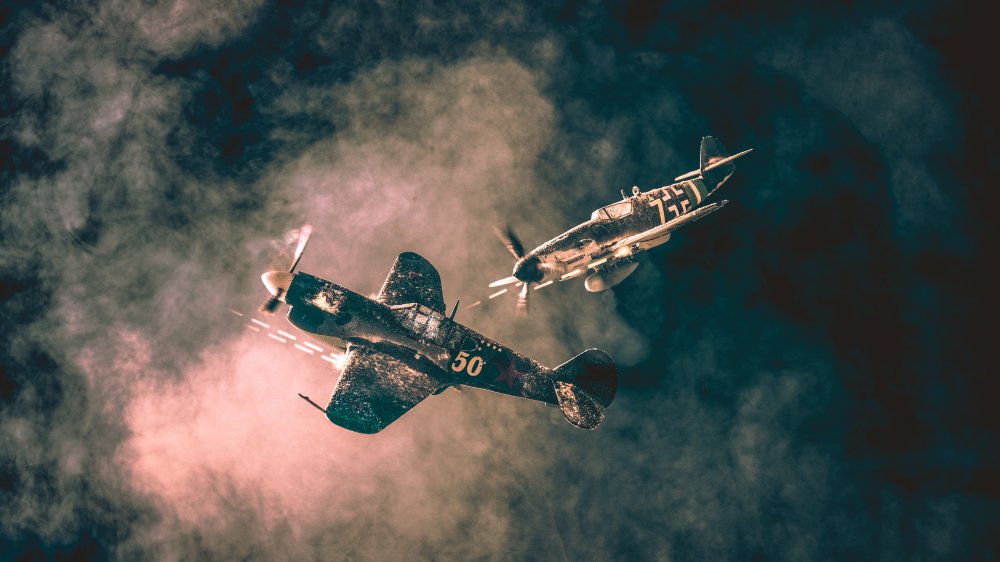The Highest Falls That People Have Survived
It's a common enough nightmare: falling. According to Cathleen O'Connor, author of The Everything Law of Attraction Dream Dictionary (via the Huffington Post), frequent dreams of falling might have something to do with what we're going through in the waking world, and often, it's a way of our subconscious reminding us of feelings of a loss of control, or situations that are on a definite downward spiral.
Thanks, subconscious.
Falling from any great height is terrifying. Just imagine standing in the open door of a plane, looking out at blue sky, and not much else. Would you jump? The feeling of plummeting toward earth in free-fall, sure, some people love it, but others? Not so much. So, here's another question: what's the farthest someone's fallen, without the safety of a parachute, and lived to tell about? It's farther than you might think, and don't worry, it'll get worse: not all of them jumped on purpose.
'This is going to hurt a lot. Or not at all.'
James Boole had a good reason to be in the air — he's an aerial cameraman who's had work featured on shows like Top Gear (via The Telegraph), and on the day that things went terribly wrong he had more than 2,500 jumps and 12 years of experience under his belt.
He spoke with The Guardian in 2009 about the accident, which happened while he was filming a documentary over the snow-covered, volcanic landscape of Kamchatka, Russia. He was following another skydiver to get footage of them flying in front of a steam vent, but then the perfect storm happened: a miscommunication, vision limited by a viewfinder, and the blank whiteness of snow. It wasn't until he was about 20 meters from the ground that he realized where he was, and he later wrote, "Terror gripped my heart and stomach, the darkest of darkness. Then I had a clear thought of my wife and 3-month-old daughter, and was overwhelmed by sadness..."
Boole pulled his chute and lifted his feet up. He hit the ground, and knew immediately that he had both survived and broken his back. An hour to a local hospital, nine hours to Moscow, then back to the UK, and he was walking within the week. Six months later, he was hoping to jump at least one more time after falling 6,000 feet.
'Those were the last words I ever heard from her'
It was 1971, and Juliane Koepcke was 17-years-old. She and her mother were in a plane over the Peruvian jungle, heading home for Christmas, when they hit heavy turbulence and lightning. There was a flash near one of the outer engines, and her mother simply said, "That is the end, it's all over." When she relayed the story to the BBC 40 years later, Koepcke said that was when the plane went into a nosedive. It broke into pieces around 10,000 feet up, and Koepcke — still strapped to her seat — was thrown clear. When she woke the next day, she was on the ground, completely alone, with a broken collarbone and some deep gashes on her legs.
It was just the beginning of her ordeal, and fortunately for her, the time she had spent with her parents at their research station had given Koepcke the knowledge she needed to survive in the rainforest. On the fourth day, she heard vultures, and found the remains of three other passengers. On the tenth day, she was having trouble standing. Then she stumbled across several men, who treated her wounds and got her back to her father.
Her mother's body was recovered on January 12, and eventually Koepcke learned that her mother had survived, too, but had been unable to walk, and died several days after the crash.
'I can fix this'
Shayna Richardson was an avid skydiver already, and in 2005, she was ready to take it to the next level: a 10,000-foot accelerated free fall, or AFF. But it didn't go as planned, and according to ABC News, not only did her main parachute fail, but her reserve failed, too. Her fall was recorded and witnessed by her boyfriend, a skydiving instructor who yelled in the background as she fell, ultimately hitting the ground face-first in an Arkansas parking lot.
Richardson appeared on The Oprah Winfrey Show in 2006, and described her injuries. In addition to breaking every bone in her face "to the point that the bone couldn't even be reused," she broke her right leg, her pelvis in three places, and knocked out a number of teeth. She was unconscious when she hit, but remembered being well aware of what was going on as she was falling, saying, "First, I'm thinking, 'I can fix this.' I've been taught what to do in this situation. I can fix this. No problem. And then the reality set in that I can't fix this. And that's when my heart sank."
There's a footnote to her story, too. While she was in the hospital, Richardson learned that she was two weeks pregnant. Miraculously, her baby survived, too, and she was able to tell Oprah that her son was absolutely perfect.
'I was kinda waiting to die'
Christine McKenzie jumped from 11,000 feet, and when she did it, it was nothing out of the ordinary. It was 2004, and it was also the 112th jump for the experienced South African skydiver, reported the BBC. This time, things went badly.
Her main parachute failed to open, and when McKenzie pulled her reserve, it opened with so much force that some of the lines snapped, and what was left became tangled and useless (via The Telegraph). In a bizarre fluke, she hit power lines on her way to the ground, and later credited them for slowing her fall enough to allow her to survive. She later said, "It all happened so fast. I hit the ground really hard and I was kind of waiting to die. Then, the pain set it."
When McKenzie got to the hospital, doctors found that she had not only survived, but survived with only a fractured pelvic bone and some bruises. She was still in her hospital bed when she told reporters that she was absolutely going to jump again.
'Oh, f***! I'm dead. Bye.'
December 2006 started out as nothing special or out of the ordinary for 25-year-old skydiving instructor Michael Holmes, but it would become the month that he survived a 15,000-foot fall.
Vice spoke with him a decade after that fateful jump, and found that he had plenty of experience — he'd already jumped more than 7,000 times when his parachute failed over Taupo, New Zealand, and it was actually the third time he'd jumped that day. Holmes checked, and double-checked his gear, then went through the third standard step of having someone else check it, too. Everything was fine, but when he opened his main parachute he started to spin. Opening his reserve chute didn't work, either, and he looked into his camera and said, "Alright, bye." Then, he hit the ground or, more accurately, he hit a blackberry bush. It didn't do much to break the fall, and he connected first with his left side. He broke his foot "pretty much off the leg," and ended up with a collapsed lung as well.
Would he do it again? Holmes told Today, "I will certainly jump. It's what I do. I love it."
'Any scheme ... seemed better than riding that plane into the sea'
Cliff Judkins was a Marine, and according to the Marion Military Academy, he enjoyed his time as a cadet. What happened in the skies over the Pacific Ocean was less enjoyable. His story was in the book Supersonic Cowboys (via the USS Los Angeles), and it started in 1963, when he refueled his F-8 Crusader (like the one pictured) 20,000 feet over the Pacific. Judkins was looking forward to dinner in Hawaii when all of a sudden, his aircraft lost power. He tried to eject, but that wasn't working, either. The plane was on fire and in a deep dive, he had only one choice: open the canopy and jump.
So he did, only for his parachute to quickly became tangled in its own lines. Judkins fell through the clouds, saw the ocean... then woke up in the water, tangled in his parachute, broken bones causing agonizing pain, with his survival kit — including a raft — gone. All that misfortune, he said, was a million-to-one coincidence.
Fortunately, a Coast Guard plane found him within the hour. Unable to land, it lowered a lanyard... and flew off. It was another hour and a half before Judkins was plucked from the sea by a ship, screaming, "Don't touch my legs!" Within a few months, he was released from the hospital, and six months later, he was back in the air.
'I had been given a second chance...'
When The Telegraph asked survival expert Bear Grylls about his most terrifying experiences, one was a parachuting accident in 1996. He was in the southern part of Africa with the military when it happened, helping an anti-poaching force. Everything about the jump was routine, he said, until his parachute tore when it opened. "I smashed into the African dust and my world went black," Grylls said later.
What followed was 18 months of rehab to come back from breaking his back in three places. He'd fallen 16,000 feet (via The Irish Post) and survived to tell the tale, saying honestly that his rehab was as much about reclaiming his confidence as it was his movement.
Grylls later said: "It was a dark time for me. [...] Sometimes it takes a knock in life to make you realize what you really value. [...] I had been given a second chance, and that doesn't always happen."
'I decided to jump and make a quick, clean end of things'
Before World War II, Nicholas Alkemade was a market gardener. When war broke out, though, he trained as an Air Gunner with the RAF and had flown 14 missions before heading off on a Berlin raid in 1945. That's when the Loughborough History and Heritage Network says Alkemade's Avro Lancaster — Werewolf — was hit. The crew started to jump, but as the rear gunner, there wasn't room for him to already be wearing a chute. By the time he reached his parachute it was on fire, which left him with a horrible choice: die in the flaming plane, or jump at 18,000 feet.
Alkemade jumped, later saying, "I had no doubts at all that this was the end of the line. [...] I decided to jump and make a quick, clean end of things. I backed out of the turret and somersaulted away."
He survived, falling through a pine tree and landing in a snowbank... where his story was just getting started. Alkemade was picked up by the Germans and sent to the POW camp Stalag Luft III (which was the location of the events of the Great Escape, which had happened a week before he got there.) He would later be among the prisoners sent walking west during the Long March, but was eventually repatriated and reunited with the woman who became his wife. Alkemade passed away in 1987, after cheating death several more times.
'I don't wish to die, because I know nothing of life'
That, says We Are the Mighty, is what US Army Air Force Staff Sgt. Alan Magee said to God as he fell from 22,000 feet. It was January 3, 1943, and Magee was one of the crew of a B-17 called Snap! Crackle! Pop! They were sent to bomb German stores in France, and when they were hit with fire from anti-aircraft guns, things went from bad to worse. The B-17 was then hit with fire from another fighter, and Magee was knocked unconscious. When he came around, he was falling.
He passed in and out of consciousness several times on the way down, and ended up falling through the glass roof of a train station in St. Nazaire. When he was found, Magee was hanging from the steel girders, with a leg broken in several places, dozens of shrapnel wounds, and an arm that was barely attached.
A German doctor saved his arm, after telling Magee that they may have been on opposite sides of the war, but his duties as a doctor came first. Magee spent the rest of the war as a POW, was part of a group officially thanked by French citizens in 1995, and passed away in 2003.
The worst thing imaginable happened to him
"The worst thing imaginable" is how LBV described what happened to Ivan Mikhailovich Chisov. At the time he was serving in the Soviet Air Force, they were knee-deep in what was called the Great Patriotic War, although other WWII Allied countries called it the Eastern Front. In January of 1942, he was part of the crew of a long-radius bomber called an Ilyushin Il-4 when they were attacked and hit by several fighters of the Luftwaffe.
What happened isn't entirely clear, but Chisov reportedly donned his parachute and jumped from around 23,000 feet. When he did, he decided to wait to open his parachute, as he didn't want to become an easy target for the Luftwaffe that was still circling. It was a dangerous choice, and he ended up blacking out and hitting the ground before he could deploy his chute.
Chisov was found by cavalry troops, and spent three months in the hospital with spinal damage and a pelvic rupture. Shockingly? When he came out, he asked to be reassigned to combat missions, but was instead assigned to be a flight instructor. (Fun fact: his ripcord was one of the artifacts recovered in Warehouse 13. It allowed the bearer to survive falls, but didn't protect against injury.)
'I was very surprised. I thought it would kill me.'
Steve Fossett is an American aviator who became the first person to fly around the world — alone — in a balloon. That happened in 2002 (via Britannica), but four years before that an attempt ended with an accident that could have killed him.
According to the Chicago Tribune, Fossett was 15,200 miles into his trip when his balloon ran into trouble over the Coral Sea. That's when he was caught in a hailstorm, and he and his balloon fell a shocking 29,000 feet. He hit the water and was immediately pulled under, and when he resurfaced things went from bad to worse. The propane burners on board set his capsule on fire, so he made the hop into the life raft.
Fossett was picked up by a 60-foot schooner called Atlanta, which had happened to be in the area when the call for help went out. He was immediately reported as being "in good condition," later saying, "It was amazing. There were tremendous sheets of hail just flooding me, and my greatest descent rate was 2,500 feet a minute. [...] I was very surprised. I thought it would kill me."
'I looked up to the sky and saw bodies'
Just what happened over the Czech village of Srbská Kamenice on January 26, 1972, is still up for debate. What we do know is that Vesna Vulović was a flight attendant who ended up on a flight from Copenhagen to Belgrade by accident: it was another attendant, also named Vesna, who was supposed to be there. Just an hour after takeoff, the plane exploded. Years later, a nearby firefighter named Zdenko Kubik recalled: "I looked up to the sky and saw bodies, suitcases, chunks of the plane falling down."
While many passengers and crew were sucked out of the plane, Vulović was trapped inside, pinned beneath a food cart. She broke three vertebrae, fractured her skull, broke her legs, and was paralyzed afterwards, with no memory of the disaster, the flight, or what followed. In 2008, she told The New York Times, "I was broken and the doctors put me back together again. Nobody ever expected me to live this long." Miraculously, she not only fully recovered but campaigned for her job as a flight attendant back. She didn't get it — instead, Yugoslav Airlines transferred her to an office job. She also entered the Guinness Book of World Records as the survivor of the "longest recorded fall without a parachute": 33,000 feet.
Vulović passed away in 2016.
There's actually a science behind surviving these falls
So how on earth is it possible to fall thousands of feet and survive, when we all know someone who's broken something just falling off a ladder? Rhett Allain is a physics professor from Southeastern Louisiana State University, and he told NPR that while it's a little tricky figuring out just what's at work here (thanks to all those pesky ethics that come up when someone suggests experimenting on this), there's a few things science does know.
For one, smaller people fall slower. They have less gravitational force pulling on them, and they're going to be moving slower when they hit the ground. When you're talking about a 10,000-foot drop, that's a big deal.
Secondly, it's all about sticking the landing. Landing on something soft — snow, a pine tree, or power lines — will help decrease the speed of the fall at the last minute.
And third? While it might seem like landing on your back is a guaranteed way of breaking it, that's actually what you want to do. Maybe. NASA research suggests we're most tolerant of G-forces when they act in a way described as "eyeballs in" — think of accelerating on a roller coaster — but that's not all there is to it. Long bones will absorb more of an impact than short ones, and while a spine will break, that gives a person a better chance at survival than taking the fall on your squishy bits. Now you know.

